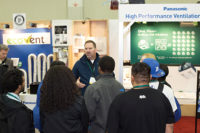If you didn’t, here’s a synopsis.
Danny Halel of ASHRAE spoke on the ISO standards process and adopting international standards. He pointed out that the first ISO standard was published in 1951. The standards have served to enhance quality and reliability.
There are now 128 national standards bodies and 2,830 technical bodies. These groups have generated 12,231 international standards “filling about 335,000 pages of text,” said Halel.
The long-range strategies for international standards development are greater direct industry/user access and increased industry/user commitment.
Halel explained that the five stages of developing an international standard are:
1. New work proposal;
2. Working draft;
3. Committee draft;
4. Draft international standard; and
5. Final draft international standard.
There is a three-year time limit to go through the five stages.
If an ISO standard is adopted into ASHRAE, the ASHRAE standard must be a duplicate of the ISO version, otherwise there needs to be a vote on any changes. An ASHRAE standard can also be adopted into ISO.
In Europe: indoor impact
Bjarne W. Olesen of D.F. Liedelt “Velta” GmbH provided an update on European standardization related to hvac and building systems.The governing bodies are the European Committee for Standard-ization (CEN) and ISO. Standard-ization goals are to apply uniform performance requirements, calculation methods, and test methods.
For standardization, you look first at the impact on the indoor environment, said Olesen. Then you look at system requirements to meet building environment needs.
He noted that there are a number of standards on the ergonomics of the thermal environment. Regarding the heating systems standard, he pointed out that a major heating method in Europe is hydronics.
In Japan: efficiency first
Koichi Watanabe of Keio University talked about energy conservation, which he noted is an important aspect for standards. Energy consumption has been increasing, and Japan now requires mandatory improvement in energy efficiency, including air conditioning.Japan’s “Front Runner” system is designed to improve the energy efficiency of manufactured household appliances. Heating and cooling systems smaller than 4 kW must meet the new standard by September 2004, with other systems to follow.
Sonny G. Sundaresan of Copeland Corp. discussed the international standard for refrigeration lubricants.
He remarked that a working group is now producing a document on lubricant standards. Classifications include miscibility and lubricants that are not miscible, as well as various viscosity grades.
The draft document covers the different working fluids, including ammonia, CFCs, HFCs, CO2, and hydrocarbons.
The working group will be meeting this May/June, with the draft document ready by July 1.





